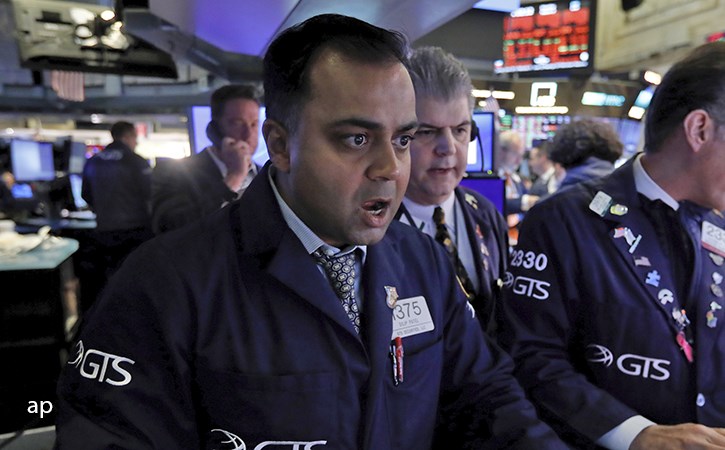
The volatility that rocked global financial markets at the start of this year compromised equity valuations and sent investors fleeing for safety. That’s left stocks undervalued, even as the headwinds that marked the start of this year show no sign of abating.
We warned at the start of this year that stocks were overvalued and that four factors would constrain market growth:
- Declining economic growth;
- Federal Reserve tightening monetary policy;
- Rising interest rates;
- Inflation.
Through the end of last month, the Morningstar US Market Index is down 13.86% this year.
However, we think this selloff has pushed the broad US equity market down too far. Following this downturn, our measure of market valuation is now well into the undervalued territory. According to a composite of the stocks followed by Morningstar’s equity research analyst team, the broad US equity market is now trading at a 12% discount to fair value.
US Equity Market Price/Fair Value, Based on Morningstar's Equity Coverage

We noted at the start of the year that value stocks were better positioned than core or growth stocks which were both overvalued.
Through the end of April, the Morningstar US Value Index declined 2.08%, whereas the Morningstar US Growth Index has dropped 25.90% and Morningstar US Core Index has fallen 12.09%. The value category trades at an 11% discount to fair value and we continue to think it has good economic tailwinds behind it.
However, growth stocks have fallen to the point where this category is now trading at a 17% discount and appears attractively priced for long-term investors.
Across market capitalization levels, the small-cap category is the most undervalued, trading at a 21% discount to our fair value. Large- and mid-cap are also both undervalued, trading at 12% and 11% discounts. Large- and small-cap stocks have fallen a similar amount, declining 14.34% and 14.27%, respectively, through the end of April. The mid-cap group declined 11.96%.
Stocks With Wide Economic Moats Trading at Significant Discounts to Fair Value
This year’s selloff has been mostly indiscriminate. Stocks for all types of companies have declined, even including those with the strongest long-term durable competitive advantages.
For example, the Morningstar US Wide Moat Index has declined 15.81%. However, valuation has played a key role in limiting the downside. Whereas this index contains all the stocks we rate with a wide economic moat, the Morningstar Wide Moat Focus Index is comprised of the 40 stocks with the lowest price/fair value ratio. Compared to the Wide Moat Index, the Wide Moat Focus Index had only dropped 9.11%.
US Equity Market Price/Fair Value Based on Economic Moat Rating

Investors can use Morningstar’s tools to find undervalued wide-moat companies and include additional screening parameters to identify attractively-valued stocks for their portfolios. Among the large-cap, wide-moat stocks we think are most attractively priced for long term investors include:

Flight to Safety Sends Defensive Sectors Too High, Growth Sectors Too Low
As the market sold off investors fled to defensive sectors, yet in most cases we think their attempt to insulate themselves from risk led them to bid up stock prices too high across these sectors. For example, the Morningstar Consumer Defensive Index rose 2.31% in April and has increased 0.97% year-to-date, one of only three sectors with a positive return this year. However, our price/fair value for the Consumer Defensive sector is 1.10, meaning it trades at a 10% premium. It is now the most overvalued sector under our coverage.
The Utility sector only fell 4.21% in April and is close to unchanged this year, having increased by 0.08%. In our view, it is also overvalued, trading at a 7% premium. In addition, we also think the Utility sector would be the most negatively impacted if inflation stays higher than longer.
Finally, the Energy sector only fell 1.66% in April but has risen 36.17% year to date. It is now trading close to fair value after coming into the year as the market’s most undervalued sector.
US Equity Market Price/Fair Value Based on Sector

Where Are The Opportunities?
Communications
This is the most attractive and by far the most undervalued sector right now. Alphabet (GOOGL) and Meta Platforms (FB) represent over 50% of the index’s market capitalization. Both are significantly undervalued and skew the valuation of the index downward. There are also a significant number of stocks in the traditional communications and media sectors that are undervalued.

Consumer Cyclical
Between high inflation and a contraction in economic growth, Consumer Cyclical stocks fell 11.82% in April, the third-worst performing sector, and are down this year 21.22%. Based on our above consensus view for economic growth over the next few years, we see significant value in this sector, especially among companies in the services industries.
Throughout the pandemic, consumers shifted their spending to goods from services. With the pandemic receding, we expect consumer behaviour will normalise and shift back towards pre-pandemic trends. We think there will be a shift of at least $450 billion just to get back to pre-pandemic trends, according to our data.

Some undervalued stocks we think could benefit from this shift include:

Financial Services
The Financial Services sector performed relatively well during the first quarter – then sank 9.36% in April, helping to cause a decline of 12.09% this year. While slowing economic growth will curtail near-term loan growth, we still expect that rising interest rates, robust economic growth, and moderating inflation will provide a good tailwind for banks. These factors will lead to rising interest income, maintaining low default rates, and lowering charge offs.
There has been a sharp drop off in valuations across the asset managers, who are typically paid as a percent of assets under management. Investors are concerned that earnings will decline with the pullback in the markets. However, for long-term investors, this pullback provides an opportunity to invest in high-quality asset managers at a wide margin of safety.

Technology
Technology stocks have been some of the hardest hit names by this year’s selloff. We viewed the sector as one of the most overvalued at the beginning of the year. Following its 21.07% pullback, we now see it as 12% undervalued.

The Four Headwinds Pressuring Valuations and Investor Sentiment
Volatility remains elevated as investors struggle with how to account for – and protect themselves from – the four headwinds we identified at the beginning of the year. We expect volatility will remain high over the next few months as it does not appear that these issues will abate until the second half of the year.
Declining Rate of Economic Growth
In our outlook for 2022, we noted the US economic growth rate was slowing from last year’s torrid pace as the economy bounced back from the pandemic-triggered freefall. Yet economic growth is slowing even more than we originally forecast. At the beginning of April, Preston Caldwell, Morningstar’s chief economist, lowered his forecast for US real growth domestic product to 3.5% from 3.7%, largely due to the effects from expected hikes to the federal-funds rate.
However, we continue to expect relatively robust economic growth in 2023 and 2024. Our real GDP growth expectations remain above Wall Street consensus by about 2% cumulatively through 2025, due to our optimistic views on the supply side of the economy, particularly labour force expansion.

Federal Reserve Tightening Monetary Policy
The most significant shift in economic data in the past month is that the market now expects the Federal Reserve to tighten monetary policy more aggressively this year.
The federal funds rate is expected to reach 3% by the end of 2022 and over 3.5% by mid-2023. This should help in fighting inflation, at the cost of slightly slower economic growth in the near term. In addition, the Fed is expected to begin letting the assets on its balance sheet roll off. We expect the Fed will begin cautiously but allow the roll off to reach a $95 billion per month run rate, which equates to reducing market liquidity by over a $1 trillion annualised run rate.
Rising Interest Rates
Interest rates continued to move up in April. In the shorter end of the curve, the yield on the two-year Treasury rose 42 bps to 2.70%, in the middle of the curve, the five-year rose 49 bps to 2.91%, and in the longer end, the 10-year rose 57 bps to 2.89%. We continue to expect interest rates will climb this year. Currently, the five-year breakeven inflation rate is 3.21% and the five-year forward inflation expectation rate is 2.41%. We expect the yield on the 10-year Treasury to trade at a premium over the average of these market implied inflation rates.

Inflation Running Hotter for Longer
Our economics team boosted our 2022 inflation forecast to 4.5% from 4.2%, due to higher energy prices stemming from the Ukraine war. We expect shortages and supply constraints to eventually ease, delivering significant deflationary pressure. We project average inflation over the next five years to be below bond market expectations by about 0.7% annually. We think the bond market has drastically overreacted to near-term inflationary pressures.

FAANG+MT: First Quarter Earnings Takeaways
Few stocks get as much investor attention as the FAANG (Meta Platforms, Apple (AAPL), Amazon (AMZN), Netflix (NFLX), and Alphabet), which we also include Microsoft (MSFT) and Tesla (TSLA).
Meta Platforms
Based on lower-than-expected first-quarter revenue and Meta Platforms’ revenue guidance for the current quarter, we slightly reduced our projections and lowered our fair value estimate 4% to $384. We view this wide-moat name attractive as it is trading near half our fair value estimate.
Meta posted mixed first-quarter results, but what stood out was the increase in both monthly and daily active users, which demonstrates that the firm’s strong network effect remains intact. Meta’s ongoing strategy to monetise Reels, which currently has lower ad prices, was partially responsible for its revenue miss, as it drove its user monetisation down slightly from last year.
However, we remain confident that over time Meta will increase Reels monetisation by attracting more advertisers with its large user base that is spending more time watching content on Reels.
Apple
We held our $130 fair value on Apple stock unchanged following earnings. Apple’s fiscal second-quarter results came in ahead of our estimates, despite supply chain constraints and the ongoing chip shortage as demand for the firm's latest iPhone 13 and MacBook Pro drove record iPhone and Mac revenue for the March quarter. However, we believe the recent stretch of strong revenue growth will be difficult to maintain as Covid-19 related Mac and iPad demand subsides.
Amazon
Following earnings, we lowered our fair value estimate 6% to $3,850 per share from $4,100. While we expect the second half of the year to show improvements, we modestly lowered our growth and profitability estimates, particularly in the near term, to account for guidance and heightened uncertainty.
Operating margin was a concern, as inflation, excesses of both labour and capacity ate into profitability, which was just above the low end of guidance, and well short of our expectations. Meanwhile, second-quarter guidance is well short of our model, as we think profitability challenges will linger for a couple of quarters and perhaps into next year. The highlight of results was strength in Amazon Web Service, which is benefiting from the ongoing to the cloud.
Netflix
We lowered our fair value 8% to $280 from $305 due to much lower subscriber growth in 2022 and slower margin expansion. The stock plunged following earnings and is now trading at enough margin of safety below our fair value that the stock rating moved into the 4-star category. This is the first time since January 2015 that the stock has traded below our fair value.
Alphabet
Alphabet reported mixed first-quarter results. Revenue came in slightly below consensus estimates while operating margin and income exceeded expectations. We maintained our $3,600 fair value following earnings. Strong growth in search advertising and cloud was partially offset by higher-than-anticipated deceleration at YouTube. In the current quarter, management expects the same trend for strong growth in search advertising will be offset by higher-than-anticipated deceleration at YouTube.
While YouTube’s ad revenue growth was a bit disappointing, we believe the platform remains well positioned to further monetise content and viewers, despite increased competition. We expect growth may begin accelerating in the fourth quarter.
Microsoft
Following earnings, our fair value estimate remained unchanged at $352. Microsoft reported solid results overall, with revenue and earnings per share coming in a bit better than we expected, despite some existing and new headwinds. We think digital transformation projects continue to fuel overall demand and we are encouraged by strength in Azure. Microsoft remains impressive in its ability to drive both growth and margins at scale and we think there is more to come on both fronts.
Tesla
Following Tesla’s earnings, we bumped up our fair value estimate to $750 from $700. The quarter exemplified our long-term thesis that Tesla has the ability to raise prices, reduce unit production costs, and cut overhead expenses, all of which will drive higher profits.
More recently, the stock had been under pressure following Elon Musk’s agreement to purchase Twitter, as investors are concerned that Musk may spend less time running the company.
However, we don't think Musk needs to closely oversee day-to-day operations, as it has shown the ability to boost production and drive profitability from operating leverage. We think Musk's direct reports should be able to run the various aspects of Tesla as the company continues to increase vehicle deliveries, reduce unit production costs, and develop autonomous driving software.














.png)













